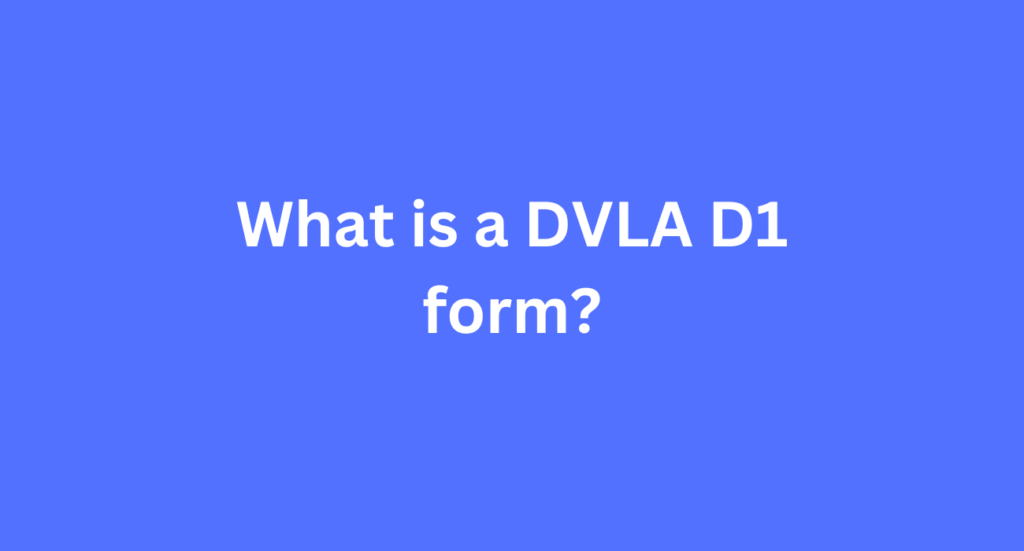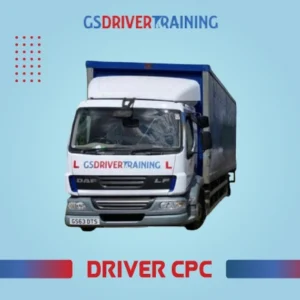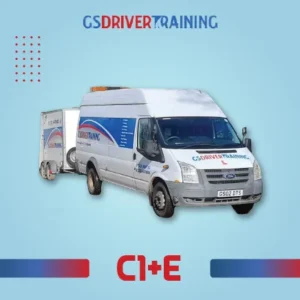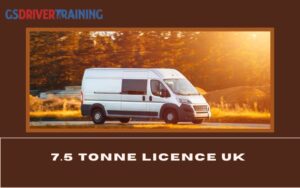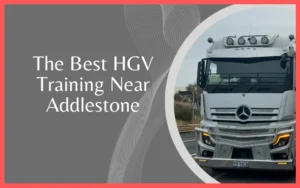What is a DVLA D1 form?
The D1 form, often called the “Application for a driving licence,” is used in the United Kingdom to apply for or renew a driving licence. It can be used for various purposes, including obtaining an HGV (Heavy Goods Vehicle) or LGV (Large Goods Vehicle) driving licence. Here’s how you can get the D1 form:
- Apply for a driver’s license online: You can download the D1 form from the official website of the Driver and Vehicle Licensing Agency (DVLA) in the UK. Visit the DVLA website and navigate to the section for forms and publications. Look for form D1 and download the PDF version. You can then print it and complete it.
- Post Office: You can also obtain a D1 form from a local Post Office in the UK. Many Post Offices have these forms available, and you can pick one up during their opening hours.
- DVLA Office: If you prefer, visit a local DVLA office and request a D1 form in person.
Once you have the D1 form, carefully complete it following the instructions. It’s crucial to fill it out accurately and provide all the necessary documentation and fees for your specific application, whether for an initial licence, renewal, or a licence category upgrade.
Remember that the D1 form is used for various driving licence-related applications, so be sure to select the appropriate purpose and complete the form accordingly. Suppose you have questions or need guidance on completing the D1 form for a driving licence application. In that case, it’s a good idea to consult the DVLA website or contact the DVLA directly for assistance.
Changing address on driving licence online explained.
In the UK, you can change your address on your driving licence online using the official government website. Here’s how to do it:
- Visit the Official Website: Go to the official government website to change your address on your driving licence. You can find this service on the GOV.UK website.
- Check Eligibility: Before you begin, ensure you can change your address online. You must be a resident of Great Britain (not Northern Ireland) and have a driving licence issued by the DVLA (Driver and Vehicle Licensing Agency).
- Create or Sign in to Your Government Gateway Account: If you don’t already have one, you must create a Government Gateway account. This account is used to access various government services, including changing your driving licence details. If you already have an account, sign in.
- Start the Process: Navigate to the section on changing your address on your driving licence. You will be asked to provide your current driving licence number, National Insurance number, and new address.
- Verify Your Identity: The system may ask you to verify your identity, often through a verification code sent to your mobile phone or email.
- Update Your Address: Once you’ve completed the verification process, you can update your address. Make sure to enter the new address accurately.
- Review and Confirm: Double-check the information you’ve entered; if everything is correct, confirm the change.
- Payment: There is usually no fee for changing your address online. However, if your driving licence is due for renewal, you might be asked to pay the standard renewal fee.
- Confirmation: You will receive a confirmation email or letter after successfully changing your address. Your updated driving licence will be sent to your new address within a few weeks.
It’s essential to keep your driving licence address current as it’s a legal requirement in the UK. Additionally, you should notify your insurance provider of the address change to ensure your policy remains valid.
At what age can you drive in the UK
In the United Kingdom, the minimum age at which you can legally drive varies depending on the type of vehicle and the type of licence you hold. Here are the general age requirements for driving in the UK:
Car (Category B) Licence:
– You can apply for a provisional driving licence at 15 years and nine months.
– You can start driving a car on public roads on your 17th birthday if you hold a valid provisional licence and are supervised by a qualified driver.
Moped (Category AM) Licence:
– You can apply for a provisional moped licence at 15 years and nine months.
– You can start riding a moped on public roads on your 16th birthday with a valid provisional licence.
Motorcycle (Category A1) Licence:
– You can apply for a provisional motorcycle licence at 17.
– You can start riding a light motorcycle on public roads on your 17th birthday with a valid provisional licence.
Motorcycle (Category A2) Licence:
– You can apply for a provisional motorcycle licence at 19.
– You can start riding a medium-sized motorcycle on public roads on your 19th birthday with a valid provisional licence.
Full Motorcycle (Category A) Licence:
– You can apply for a full Category A motorcycle licence at 24 or after holding an A2 licence for two years if you are 21 or older.
– You can ride a motorcycle of any size on public roads once you have a full Category A licence.
Large Goods Vehicle (LGV):
– The minimum age for obtaining these licences varies, but you need to be at least 18 to start the process.
Carrying Vehicle (PCV) Licences:
The minimum age for obtaining these licences varies, but you need to be at least 21 to start the process.
These age requirements are subject to change, and there may be additional conditions and restrictions based on the type of licence you’re applying for. Always check the latest requirements and needs on the official government website or with the UK Driver and Vehicle Licensing Agency (DVLA).
What is a Photocard Driving Licence
A photocard driving licence is a type of driving licence that includes a photograph of the licence holder. It has largely replaced the older-style paper driving licences in the United Kingdom. Here’s some important information about photocard driving licences:
- Appearance: A photocard driving licence is a plastic card that features a photograph of the licence holder on the front, along with various personal details, including the full name, date of birth, and address.
- Security Features: To prevent forgery and enhance security, photocard driving licences come with various security features, such as holograms and other elements designed to make it difficult to counterfeit.
- Categories: The photocard driving licence is issued in different categories, each corresponding to the type of vehicle you are permitted to drive. For example, the Category B licence allows you to drive a car, while other categories enable you to drive motorcycles, large goods vehicles, passenger-carrying vehicles, and more.
- Validity: Photocard driving licences are generally valid for ten years, after which you must renew them. You must also ensure that your photograph and personal details on the card remain current, and you should inform the DVLA (Driver and Vehicle Licensing Agency) of any changes in your personal information.
- Photo Updates: If your appearance changes significantly due to age or other factors, you may need to update your photograph on the photocard driving licence before its expiration date.
- Photocard and Paper Counterpart: In the past, the photocard driving licence was issued along with a paper counterpart, which included details like endorsements and penalty points. However, as of June 8, 2015, the paper counterpart is no longer valid or issued. All relevant information, including endorsements, is stored electronically.
- Legal Requirement: A legal requirement in the UK is to have a valid driving licence when operating a vehicle on public roads. Failure to produce your licence when requested by a police officer can result in penalties.
To apply for or renew a photocard driving licence, you can do so online through the official government website or by postal application using the appropriate forms provided by the DVLA. Always ensure that your driving licence is current and that any changes in your details are promptly reported to the DVLA.
DVLA forms
The DVLA (Driver and Vehicle Licensing Agency) in the United Kingdom provides various forms necessary for driving and vehicle management. These forms include applying for a driving licence, taxing your vehicle, declaring SORN (Statutory Off Road Notification), and more. You can obtain and submit these forms through different channels, including online and postal methods. Here are some common DVLA forms and their purposes:
D1 – Application for a driving licence: This form is used to apply for a driving licence and renew or change an existing licence.
D2 – Application for a lorry/bus licence: If you’re applying for a lorry or bus licence, this form is used for the initial application..
V62– Application for a vehicle registration certificate: This form is used to apply for a replacement V5C (logbook) if lost, stolen, or damaged.
V5C – Application for a vehicle registration certificate: You use this form to notify the DVLA of changes to your vehicle, such as a change of ownership or address.
V11 – Renewing your vehicle tax: This form is used if you need to renew your vehicle tax (car tax). You can also renew your tax online.
V890 – Statutory Off-Road Notification (SORN): If you want to declare your vehicle off the road and stop taxing it, you can use this form.
V85/1 – Application for a trade licence to operate an MOT testing station: This form is for those looking to become an MOT tester.
V890/1 – Applying for a duplicate MOT certificate: This form is used to get a replacement MOT certificate if yours has been lost or damaged.
V888/2 – Vehicle details: This form requests vehicle information from the DVLA.
V888/3 – Vehicle enquiry for first registration or used imported vehicles: Use this form for vehicle registration and import-related inquiries.
These are just a few examples of DVLA forms. To obtain the correct form for your specific needs, visit the official DVLA website and use their form finder tool. This tool will help you locate the appropriate form and provide guidance on completing and submitting it. Remember that many DVLA services, including some form submissions, can be completed online.
FAQ
1. What is the D1 form?
The D1 form is an application form used in the UK to apply for a driving licence or make changes to an existing licence.
2. Who should use the D1 form?
Anyone who needs to apply for their first driving licence, renew an existing licence, change their name or address, or exchange a foreign licence for a UK licence should use the D1 form.
3. Where can I get a D1 form?
You can obtain the D1 form from a Post Office, order it online from the DVLA website, or collect it in person from a DVLA local office.
4. Can I fill in the D1 form online?
Yes, you can complete the D1 form online and submit it electronically. However, some sections, like the medical questionnaire, may require a paper application.
5. What information is required to fill in the D1 form?
You’ll need your personal details, such as your name, address, date of birth, and nationality. You’ll also need information about any medical conditions or disabilities that may affect your ability to drive.
6. What documents should I include with the D1 form?
The required documents may vary depending on your specific application. Commonly, you’ll need to include identity documents, a passport-sized photograph, and any necessary medical reports.
7. How do I pay for my D1 application?
You can pay the application fee by cheque or postal order if you’re applying by post. When applying online, you can pay using a credit or debit card.
8. How long does it take to process a D1 application?
Processing times may vary, but you should typically receive your new licence within three weeks if your application is straightforward. Medical assessments or foreign licence exchanges may take longer.
9. Can I track the status of my D1 application?
You can track the progress of your D1 application by using the DVLA’s online tracking service.
10. What if I make a mistake on the D1 form?
If you make a mistake on the D1 form, you should contact the DVLA for guidance on how to correct it. It’s important to provide accurate information.
11. Can I fill in the D1 form on behalf of someone else?
Yes, you can complete the D1 form on behalf of someone else if they have given you permission. However, their signature is typically required in the relevant sections.
12. Is there an age requirement to fill in the D1 form?
– The age requirement depends on the type of licence you’re applying for. For a car (Category B) licence, you can apply at 15 years and 9 months, but you can only start driving at 17. Other licence categories may have different age requirements.
13. What does am on driving licence stand for?
The AM on a driving licence typically indicates that the holder can operate mopeds and light quad bikes. It’s a category that permits the operation of small, low-powered vehicles.
14. How can I obtain a new driving licence if my current one is lost, stolen, or damaged?
If your driving licence is lost, stolen, or damaged, you can apply for a new one using the DVLA’s D1 – Application for a driving licence: This form is used to apply for a driving licence, renew or make changes to an existing licence. This form allows you to request a replacement licence, and you can submit it by post along with the necessary documents and fees. You can apply for a new driving licence online if you’re eligible.
15. What is the Post Office D1 form, and how is it related to applying for a driving licence?
The Post Office D1 form is a paper-based application form used to apply for a driving licence or make changes to an existing licence. It can be obtained from the Post Office. While you can apply for a driving licence online, the D1 form is used for postal applications. It’s important to choose the appropriate method (online or postal) based on your preference and the type of application you need to complete.
Also Read: How to get an HGV licence?

